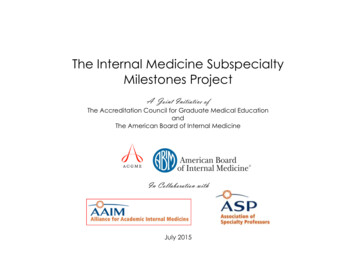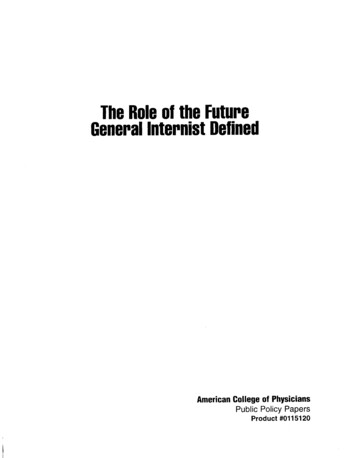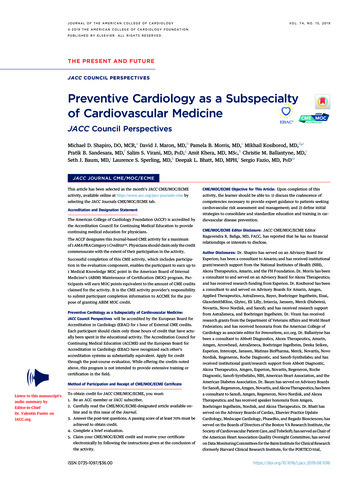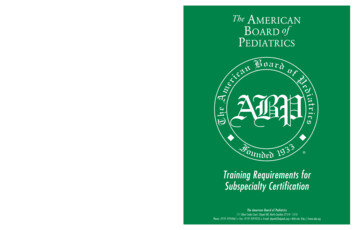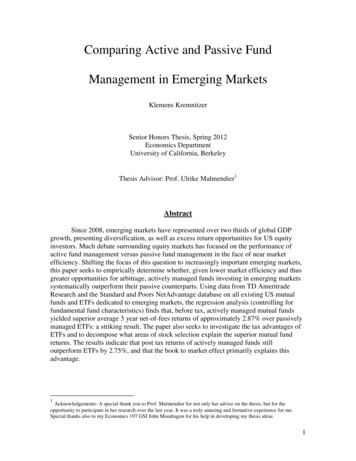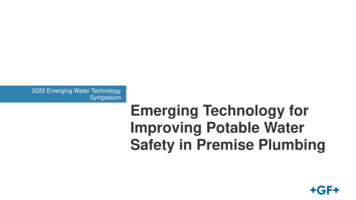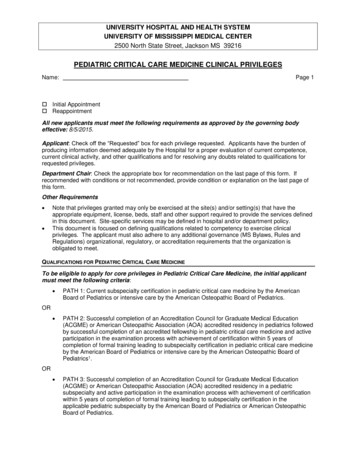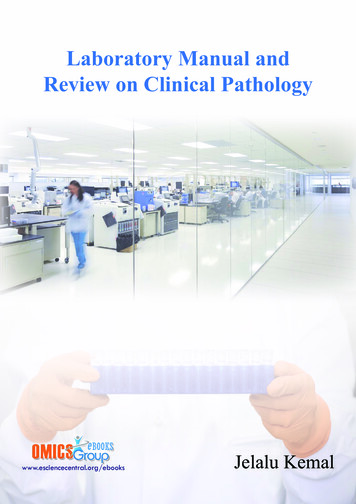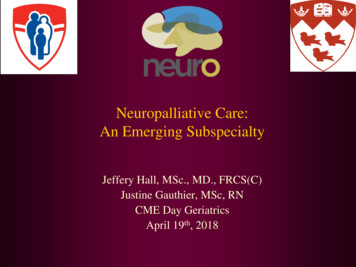
Transcription
Neuropalliative Care:An Emerging SubspecialtyJeffery Hall, MSc., MD., FRCS(C)Justine Gauthier, MSc, RNCME Day GeriatricsApril 19th, 2018
Disclosure Consultant to Novartis (JH) Susan Cameron Cook Program inNeuropalliative Care Rossy Family Foundation forNeuropalliative Education
Learning Objectives1. Describe a “palliative approach” to patients withneurologic illnesses2. Identify the major subtypes of neurologicillnesses and their demographics3. Manage common clinical scenarios including;increased intracranial pressure, seizures, seriousillness conversations and discussions regardinglevels of care
What is Palliative Care?
Neurosurgical procedures for intractable pain; Spinal Cord Stimulation Intrathecal Pumps Motor Cortex Stimulation Deep Brain Stimulation Cordotomy Mesencephalotomy
WHO definition of Palliative Care? An approach which attempts to prevent oralleviate physical, social, psychological andspiritual suffering without hastening death orprolonging life (1).
Our definition of Palliative Care(Supportive Care) Symptom control and practical support topatients and their caregivers with a primacy onquality of life from first contact, throughterminal care, death and bereavement.
Paradigm Shift Supportive care focuses on the relief ofsuffering and planning for decline and deathas an expected and natural outcome and notas a failure of medical treatment (4).
What is Palliative Care is NOT The end of hopeAdmission of defeatFailure of treatmentWho you call when “nothing more can be done”
PC/SC Skill Sets Symptom assessment and managementCommunication of bad new (SIC)Advanced care planning (LOC)Caregiver assessment (family and team)
Is there evidence in favour of SupportiveCare? 2010 study in NEJM which randomized 151newly diagnosed metastatic non-small-cell lungcancer into a group receiving standard oncologictreatment and into one receiving standardtreatment with Palliative Care from the time ofdiagnosis.
Temel Study (2010) Is QOL and mood affected over 12 weeks by earlyintroduction of Palliative Care? Those still alive at 12 weeks (86%) indicated betterQOL and lower depression scores (Palliative CareDoctors don’t make patients depressed!) Fewer patients in the PC group received aggressivemeasures at the EOL and median survival was over2 months longer (Palliative Care extended theirlives by 20%)
Palliative Care in - addition to standardtherapy - is a more effective interventionthan standard therapy alone!
Neuro Palliative / Supportive Care The applied principles of Palliative Care to patients withneurologic diseases: Brain cancer Stroke Dementia Traumatic brain injury (TBI) Chronic pain Neuromuscular diseases (ALS) Inflammatory disorders (MS) Movement disorders (Parkinson’s Disease-PD)
Unique needs of Neuro patients Neurologic diseases are largely incurableand reduce life expectancy. Neurologic diseases have a vastly morevaried trajectory than cancer patients and arecharacterized by cognitive impairment,behavioural issues and communicationproblems.
Supportive Care Training? In the USA there is a separate board certificationprocess for Hospice and Palliative Medicinerecognized by the American Board of Psychiatry andNeurology (ABPN) In Canada, starting July 2017, the Royal College hasintroduced a two-year speciality in Palliative Medicinefollowing Internal Medicine, Anesthesia or NeurologyCertification In Europe there is a two year training programfollowing Internal Medicine Certification
12/411p3%NeuroPC
41/1254p3%NeuroPC
352/352p100%NeuroPC
100%NeuroPC
Neurology & PC/SC Less than 1% of Neurologists are boardcertified in Palliative Medicine and fewerthan 2% of Palliative Care Clinicians areNeurologists.
Neurosurgery & PC/SC No training requirements. Uncertainty about when to involve PC/SCin the disease trajectory of a patient.
How can we support it? Establish an on-site service that works incollaboration with existing services ofMUHC and McGill Palliative / SupportiveCare Training and Teaching Research
Essence of Supportive Care Service Patient and family centred care delivered by a team Whole-person care Dedicated Nursing (Justine Gauthier) Administrator (Luisa Birri) Psychology Social work/Physiotherapy/Occupational therapy Rehabilitation services / Geriatrics Spiritual Care Volunteers Complimentary therapy (Art, Music, Massage, Pets) Legacy projects Ambulatory clinics Home care program Teaching Research
Who consults NPC? We are in the process of conducting areview of the inpatient consultations fromour hospital. The vast majority involvepatients with cerebrovascular, oncologic andneuromuscular diagnoses. This review will be presented at the 22ndInternational Congress on Palliative Care,October 2-5th, 2018, Montreal
Demographics of “Neuro” patients Neuro-oncology (Malignant Glioma)Cerebrovascular (Stroke)Neuro-inflammatory (Multiple Sclerosis)Movement disorder (Parkinson’s Disease)Neuromuscular (Amyotrophic LateralSclerosis) Neurodegenerative (Dementia) Traumatic Brain Injury (TBI)
Malignant Glioma Incidence: 4-5/100,000Prevalence: 10/100,000Average age at diagnosis: 64Life expectancy: 14, 5 months
Stroke Incidence: 269/100,000Prevalence: 980/100,000Average age at diagnosis: 56Life expectancy: High risk of death in thefirst month especially for hemorrhagic(63.3%) or subarachnoid (58.6%) strokecompared to ischemic stroke (9%).
Multiple Sclerosis Incidence: 8/100,000Prevalence: 208/100,000Average age at diagnosis: 36Life expectancy: 5-10 years less thanaverage population
Parkinson’s Disease Incidence: 13/100,000 Prevalence: 150/100,000–40-49: 40/100,000–50-59: 106/100,000–60-69: 428/100,000–70-70: 1,086/100,000– 80:1,903/100,000 Average age at diagnosis: 66 Live expectancy: Same as average
Amyotrophic Lateral Sclerosis Incidence: 2/100,000Prevalence: 4.4/100,000Average age at diagnosis: 55Life expectancy: 2-5 years
Traumatic Brain Injury Incidence: 500/100,000Prevalence: 1M CanadiansAt risk ages: 0-4, 15-19 and 65Life expectancy: Leading cause of death(and disability) in people less than 40
Dementia Incidence:– 65-74: 200/100,000– 75-84: 1300/100,000– 85: 3700/100,000 Prevalence: in 65 year 5,234/100,000 Average age at diagnosis: 74 Life expectancy: Decreased (fifth leading causeof death in persons 65 and older in US)
Palliative Approach Identify sources of suffering in patients andtheir families and caregivers with specificneurologic diseases Undergo training to develop SupportiveCare skills in physicians and paramedicalstaff caring for Neuro patients Participate in training of medical students,residents, fellows, nurses and paramedicalstaff
Practical Management Increased intracranial pressureSeizuresDecreased communicationSerious illness conversationsDiscussions regarding levels of care
Intracranial Pressure (ICP) Monro-Kellie Doctrine: the sum of the volumesof intracranial contents (CSF, blood and brain)are constant and bounded by bone an increase in volume in any component mustbe compensated for by a decrease in anotheror the ICP will increase as ICP increases symptoms become moresevere from headache, nausea and vomiting todecreased level of consciousness, coma, braindeath and death
Elevated ICP - Diagnosis Imaging will detect a mass lesion (tumour,blood or pus) or hydrocephalus.
Elevated ICP - Treatment Surgical Decompression CSF diversion (shunt, EVD, LP) Pharmacologic Dexamethasone Hypertonics (mannitol, 3% NS) Acetazolamide
Elevated ICP - Treatment Non-pharmacologic Positioning Elevate HOB No restrictions jugular venous return
Persistent Seizures Many patients with neurologic illnesses willhave seizures and be taking a variety of antiepileptic drugs (AEDs) Towards the end of life they may not be able totake AEDs orally Sedation protocols for these patients shouldfavour benzodiazepines over antipsychoticsand seizure protocols using SQ medicationsshould be available to nursing staff
Definition of Seizure Transient occurrence of signs and/or symptoms due toabnormal excessive or synchronous neuronal activity in thebrain
ILAE Definition of EpilepsyEpilepsy is a disease of the brain defined by any of the following conditions1. A least two unprovoked (or reflex) seizures occurring 24 h apart2. One unprovoked (or reflex) seizure and a probability of further seizures similar tothe general recurrence risk (at least 60%) after two unprovoked seizures, occurringover the next 10 years3. Diagnosis of an epilepsy syndromeEpilepsy is considered to be resolved for individuals who had an age-dependent epilepsy syndrome butare now past the applicable age or those who have remained seizure-free for the last 10 years, with noseizure medicines for the last 5 years.
ILAE Seizure Classification
Terms no longer in use Complex partialSimple ary generalized tonic-clonic
Less common but important seizure patterns inEOL care Epilepsia partialis continua Non-convulsive status Prolonged post-ictal confusion
Seizure Protocol Lorazepam 1-2 mg PO/SL/SQ for 3 or more focalseizures or one generalized seizure repeat Q 15minutes until seizures stop OR Midazolam 2,5-5mg SQ Q15 minutes untilseizures stop If seizures continue: Phenobarbital 30-60 mg SQ If seizures continue : Continuous IV or SQ sedation
Decreased communication Practically speaking this is a hallmark ofmost patients with neurologic illness at somepoint in their disease trajectory Even experienced clinicians are oftenuncomfortable with the assessment andtreatment of these patients FIGHT DISCRIMINATION OF THEDOMINANT HEMISPHERE!
Dominant hemisphere For the vast majority of patients the left hemisphere iscritical to language comprehension and production Neurologic illnesses which primarily affect thishemisphere pose unique challenges and we mustremain vigilant to avoid deferring to family Inability to communicate verbally does notnecessarily imply globally impaired cognition Memory and understanding may be intact
How to overcome hemispheric discrimination? Spend the same amount of time (or maybeeven more) in the presence of patients withimpaired communication to establish rapport
Serious Illness Conversation
Advanced care planning Current literature reveals that most patients want toknow (even if the news is bad) and that they can begiven this news without distress or lack of hope(6). Moreover, discussions of EOL are associated withearlier referral to hospice/PC and less aggressivemedical care near death. Aggressive care neardeath is associated with worse patient QOL andworse caregiver bereavement (7).
Serious Illness Conversation GuideMD, Nurses, PT, OT, SW, Spiritual CareUnderstanding What is your understanding now of where youare with your illness?Goals If your health situation worsens, what are yourmost important goals?Fears/Worries What are your biggest fears and worries aboutthe future with your health?Ariadne Labs (2015). Serious Illness Conversation Guide. Available online at: usillness/
Serious Illness Conversation GuideFunction What abilities are so critical to your life that you can’timagine living without them?Trade-offs If you become sicker, how much are you willing to gothrough for the possibility of gaining more time?Family How much does your family know about yourpriorities and wishes?Ariadne Labs (2015). Serious Illness Conversation Guide. Available online at: usillness/
Practical strategies – For MDs Consider care transitions as opportunities forconversations about goals of care Recent hospitalisation Admission to a nursing home If you realize you would not be surprised if yourpatient died within the next year If your patient had a recent functional decline If your patient is receiving third-line chemotherapyD’Intino, A. F. (2017). Having Conversations With Patients About Serious Illness. Cancer Care Nova Scotia 5 (4).Lakin et al. (2016). Improving communication About Serious Illness in Primary Care: A Review. JAMA Internal Medicine, 176(9), 13801387.
Levels of care and cardiopulmonaryresuscitation form To be used by all patients in the province ofQuebec. Implemented at the MUHC in May, 2018
Pamphlet available to patients inEnglish and French
Thank you
References 1). World Health Organization. World Health Definition of Palliative Care. 2013. Available /en/. 2. Early Palliative Care for Patients with Metastatic non-small-cell lung cancer. (2110). Temel, J.S.,Greer, J.A., Muzikanshy, A., Gallagher, E.R., Adman, S., Jackson, V.A., Dahlin,C.M. Blinderman,C.D., Jacobsen J., Pirl,W, F., Billings, J.A. and Lynch, T.J. NEJM. 363:8:733-742. 3.Dallara, A. and Tolchin, D.W. (2014). Emerging subspecialties in Neurology: Palliative Care.American Academy of Neurology. 82:640-642. 4. Boersma. I. Miyasaki, J., Kutner, J., and Kluger, B. (2014). Palliative care and neurology: aparadigm shift. Neurology. 83(6):561-567. 5. Borasio, G.D. (2013). The role of palliative care in patients with neurologic diseases. NatureReviews Neurology. 9:292-295. 6. Smith, Thomas, J., Dow, L.A., Virago, E., Khatcheressian, J., Matsuyama, R. and Lyckholm, L.J.(2001). A pilot trial of decision aids to give truthful prognostic and treatment information tochemotherapy patients with advanced cancer. Journal of Supportive Oncology. 9(2):79-86. 7. Wright, A.A., Zhang, B., Ray, A., Mack, J.W., Trice, E., Balbone,T., Mitchell, S.L., Jackson, V.A.,Block, S.D., Maciejewski, P.K. and Prigerson, H.G. (2008). Associations between end-of-lifediscussions, patient mental health, medical care near death, and caregiver bereavement adjustment.Journal of the American Medical Academy. 300(14):1665-1673. 8. Robinson, M.T. and Barrett, K.M. (2014). Emerging Subspecialties in Neurology: neuropalliativecare. American Academy of Neurology. 82:180-182.
Intracranial Pressure (ICP) Monro-Kellie Doctrine: the sum of the volumes of intracranial contents (CSF, blood and brain) are constant and bounded by bone an increase in volume in any component must be compensated for by a decrease in another or the ICP will increase as ICP increases symptoms become more
